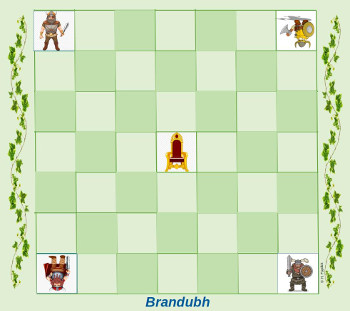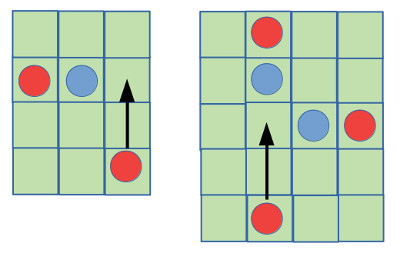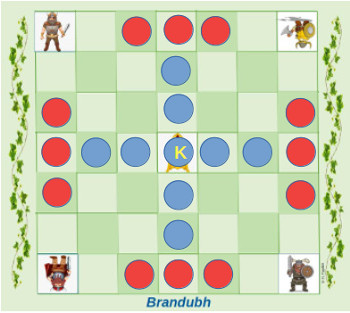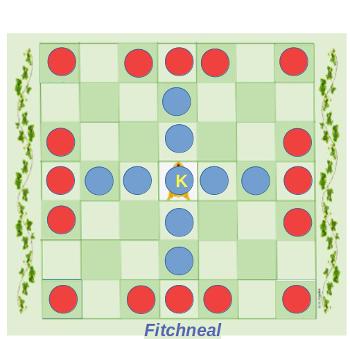Brandubh and Fitchneal
Written by Howard Fosdick © BestFreeNewGames.com
Overview: Tafl games -- checkers- or chess- like games featuring unequal forces -- stretch back into antiquity. They're often identified with the Viking and Celtic cultures, as numerous game boards of various types have been unearthed from that era in the British Isles.
Brandubh and Fitchneal are based on archaeological finds in Ireland. They're somewhat simpler, more approachable games than the more grandiose versions of tafl, which are played on large boards with dozens of men. Brandubh and Fitchneal are played on a 7 by 7 board with fewer men. This makes them highly playable and an eminently enjoyable.
We'll describe Brandubh first, then its 21-piece variant, then Fitchneal.
Brandbudh
Players and Equipment: This is a two-player game.
To play, you'll need a board and several markers. We provide free printable game boards here. That webpage also tells how you can easily acquire the necessary game pieces.
The Board: Here's how the playing area looks:

The board measures 7 squares by 7 squares. The center square is the throne of an Irish King. The four outermost corner squares of the board, represented by warrior images in the sample board, have a special role that we'll explain in a minute.
To start, each player places his markers on the board as shown in the second figure. The Defender places his King on the center square. The King is the sole gaming pieced that must be distinguishable from all the others.
Then, Defender places his 4 soldiers around the Irish King as shown, and the Attacker places his 8 red attacking Vikings as illustrated.
The Attacker always takes the first turn of the game. Then players alternate turns, each moving one piece per turn. Moving in your turn is mandatory (assuming it is possible).

Objectives: Both sides have different objectives.
The goal of the Attacker is to capture the King.
The goal of the Defender is to move the King safely to any corner square. Thus he escapes the Viking invaders.
Movement:
All pieces -- including the King -- move in the exact same manner. In a single turn, they move as many squares as desired, either vertically or horizontally. They never move diagonally. They can not move through or jump over other pieces. Only one token may occupy any square at any one time. In short, all pieces move like the Rook in Chess.
Capturing:
These are the rules of capture for all pieces -- except for the King.
To capture an enemy piece, you move your two tokens into position on each side of it, immediately adjacent. Your soldiers enclose the enemy, either vertically or horizontally. The accompanying figure shows an example.
Captured pieces are immediately removed from the board and from play.
You can capture more than one piece in a single move if you enclose them with your markers. See the figure for an example.
A soldier can never move into capture. In other words, if two enemy pieces have an unoccupied square between them, you can move your soldier into that square and he is not captured (suicide is not permitted).
The King can help capture enemy soldiers just like any other piece.

Special Squares:
Only the King may occupy the center square (the throne). Other pieces may move through it, but they may not occupy it.
The King may not re-occupy his throne once he has left it. And only the King may occupy the four outermost squares (represented in our game board by the four warrior images).
The four corner squares have a special property. They act like hostile soldiers to both armies. So if a soldier is positioned between an enemy piece and a corner square, he is considered captured and immediately removed from the board.
The central square is hostile to all pieces in the same way that the four corner squares are. If a player positions an enemy piece between his own piece and the central square, that soldier is captured.
How to Capture The King:
- When on the central square, the King can only be captured by surrounding him with attackers on all four sides.
- Elsewhere on the board, the King is captured the same way as any other piece. This includes capture between a hostile corner square and an enemy soldier.
- If the King and all his men are surrounded by Vikings such that he can not possibly move to a corner square he is considered captured.
How the Game Ends:
The Attacker wins if he captures the King.
The Defender wins if the King safely moves to any corner square.
If one player can not move (and the other still can), the player who can still move his pieces wins.
If neither player can move (and moving a piece in one's turn is mandatory), then the game ends in a draw.
If both players repeatedly make the same moves (more than two times), then the game ends in a draw.
How the Winner is Determined:
Since the game is unequal, the best way to determine who wins is to play a pair of games, so that each player can play each side. Or play any number of games divisible by two, again, so that each participant gets to play each side the same number of times.
In this way you can fairly determine "the grand winner".
-----------------------------------
Variants:
Some also play using any of these alternate rules:
- When the King is on a square immediately adjacent to the central square, he may be captured by surrounding him on the remaining three sides with attackers.
- The throne square is not hostile to Defender soldiers when the King sits on his throne. If the King is not on the central square, it is hostile to both defending and attacking pieces.
- The King is allowed to re-enter his throne once he has left it.
- The King can only move a single square in his turn. (Like all pieces, movement is only horizontally or vertically, never diagonally.)
- In some tafl games, the King only has to reach any square on the board's perimeter, instead one of four specific corner squares. (See the description of Fitchneal below.)
- In some tafl games, the Defender must announce if the King has a clear path to escape. The Defender can only use this path in his next turn, and only if he has announced it previously.
For new players, I'd ignore the first three rules because they add complexity. But they might prove useful to experienced players. The last three rules alter the game into something else entirely.
-----------------------------------
Tips for Play:
Unequal forces and different objectives prompt each player towards different strategies. The Defender needs to husband his smaller army, meaning that a straight trade-off between captured men is to his disadvantage.
Above all, the Defender must protect his King. A key question for the Defender is when to move his King from his throne. Remember that the King can not return to the center square once he leaves it. He's much harder to capture on his throne, because he can only be captured there when surrounded by four orthogonal pieces. In contrast, once away from the throne, the King is subject to capture by two pieces -- or one piece and a corner square -- the same as another marker in the game.
Yet the Defender has several key motivations to move the King from his throne. First, that's the way to win: get the King to a corner square. Also, the Defender only has four pieces other than the King -- compared to the Attacker's eight men -- and so getting the King involved in capturing enemy soldiers helps even the playing field.
The Attacker has different concerns. In general, he has a larger army, but since he can only move one piece per turn, he suffers a disadvantage in coordinating and maneuvering his army. A one-to-one trade-off in pieces advantages the Attacker, since he has more pieces.
Dislodging the King from his throne and getting him into the open makes him easier to capture. But of course, it's a game-ending error if the King obtains any of the four corner squares.
Sometimes it's to the Attacker's advantage not to capture enemy pieces that obstruct a possible pathway for the King to attain a corner square. A cluttered board works to the Attacker's defensive advantage. But of course, it may make it more difficult to capture the King on this throne.
Most consider that the Defender has a slight advantage in Brandubh. That's why it is important to play two games so each participant gets to play both the Defender and Attacker roles.
Brandubh with 21 Pieces and Fitchneal
Brandubh can also be played with 21 pieces on the board, instead of 13. The Attacker has 12 pieces while the defender has 8 plus his King, for a total of 9.
All rules remain the same in the 21-piece game. The figure shows how to initially position soldiers in this version.

Fitchneal: Another variant of the game in historical Ireland is called Fitchneal. It plays with a total of 24 pieces plus one King. The Fitchneal starting layout is shown in the figure below.
All rules remain the same as in Brandubh except one: there are no hostile corner squares. The corner squares are treated just the same as any of the other squares on the board (except for the King's throne). In this game it makes sense that the King can escape to any perimeter square on the board, not just the four corner squares.

-----------------------------------
Print Your Own Game Board:
For a choice of several free printable game boards you can use
click here. You don't need to buy anything to play!
-----------------------------------
More About Tafl:
Read more about tafl games and their history
here.
Click here for more free games on this website.
-----------------------------------
Sources:
Probably the best single source of Brandubh rules are those of the
World Tafl Federation. You can read them
here.
Beyond that, the rules here were compiled by visiting as many websites as possible that cover this game, then checking and comparing their rules against one another. Ultimately, there is no authoritative source for an historical game like Brandubh for which no primary sources exist. Play with the rules you like best!
If you like board games, visit our pages on Teeko, Camelot/Cam/Camette,
The Jungle Game,
and Ringo.
-----------------------------------
License: Feel free to print, copy, and distribute these rules, so long as you retain this paragraph. Written by Howard Fosdick © 2023, distributed under Creative Commons License BY-ND. HOME